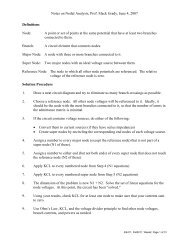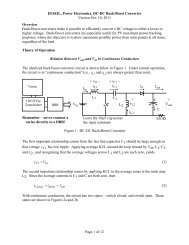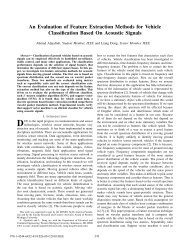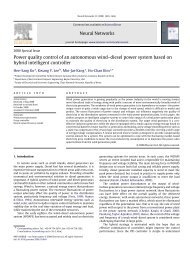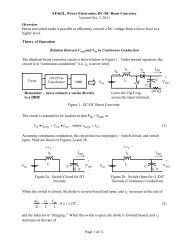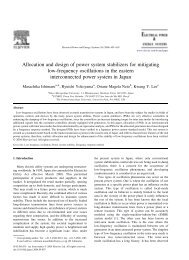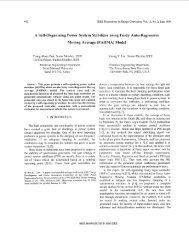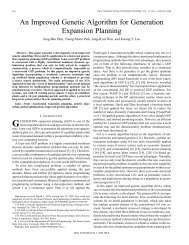The Laplace transform on time scales revisited - ECS - Baylor ...
The Laplace transform on time scales revisited - ECS - Baylor ...
The Laplace transform on time scales revisited - ECS - Baylor ...
Create successful ePaper yourself
Turn your PDF publications into a flip-book with our unique Google optimized e-Paper software.
1292 J.M. Davis et al. / J. Math. Anal. Appl. 332 (2007) 1291–1307Definiti<strong>on</strong> 1.1. For f : T → R,the<strong>time</strong> scale or generalized <str<strong>on</strong>g>Laplace</str<strong>on</strong>g> <str<strong>on</strong>g>transform</str<strong>on</strong>g> of f , denoted byL{f } or F(z), is given byL{f }(z) = F(z):=where g(t) = e ⊖z (t, 0).∫ ∞0f(t)g σ (t) t, (1.1)<str<strong>on</strong>g>The</str<strong>on</strong>g>y go <strong>on</strong> to state that the <str<strong>on</strong>g>transform</str<strong>on</strong>g> is defined for some appropriate collecti<strong>on</strong> of complexnumbers z ∈ C for which the integral c<strong>on</strong>verges, but give no inversi<strong>on</strong> formula for the <str<strong>on</strong>g>transform</str<strong>on</strong>g>.Instead, they give the <str<strong>on</strong>g>transform</str<strong>on</strong>g> of the elementary functi<strong>on</strong>s and show the uniqueness of their<str<strong>on</strong>g>transform</str<strong>on</strong>g>s by using the uniqueness of soluti<strong>on</strong>s to ordinary dynamic equati<strong>on</strong>s.<str<strong>on</strong>g>The</str<strong>on</strong>g> goal of this paper is first to quantify a subset of the complex plane for which the integralc<strong>on</strong>verges; that is, establish a regi<strong>on</strong> of c<strong>on</strong>vergence in the complex plane for (1.1). Furthermore,we provide a relatively simple inversi<strong>on</strong> formula and show that inverses are uniquely determinedby it. Finally, a noti<strong>on</strong> of c<strong>on</strong>voluti<strong>on</strong> arises and its algebraic structure is explored. Inthis process, the identity element is determined to be the appropriate analogue of the Dirac deltafuncti<strong>on</strong>al.Definiti<strong>on</strong> 1.2. <str<strong>on</strong>g>The</str<strong>on</strong>g> functi<strong>on</strong> f : T → R is said to be of exp<strong>on</strong>ential type I if there exist c<strong>on</strong>stantsM,c > 0 such that |f(t)| Me ct . Furthermore, f is said to be of exp<strong>on</strong>ential type II if thereexist c<strong>on</strong>stants M,c > 0 such that |f(t)| Me c (t, 0).<str<strong>on</strong>g>The</str<strong>on</strong>g> <strong>time</strong> scale exp<strong>on</strong>ential functi<strong>on</strong> itself is of type II. In their work <strong>on</strong> the stability of the<strong>time</strong> scale exp<strong>on</strong>ential functi<strong>on</strong>, Pötzsche, Siegmund, and Wirth [6] show that the <strong>time</strong> scalepolynomials h k (t, 0) are of type I.Throughout this work, we will assume that T is a <strong>time</strong> scale with bounded graininess, thatis, 0






